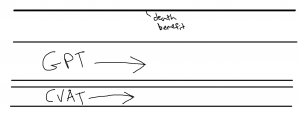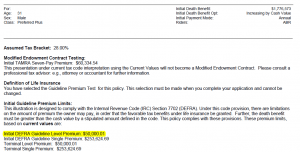Last time I talked about designing cash value life insurance as an asset class using whole life insurance, today we'll dive into how it works for universal life insurance.
Universal life insurance is often used by agents as a lower premium permanent life insurance option as compared to whole life insurance, huge mistake. As a product that seeks to establish a permanent death benefit, it needs adequate incoming money to build an appropriate reserve to ensure the policy's sustainability.
How do you Qualify for Life Insurance?
Following the Deficit Reduction Act of 1984 (DEFRA) all life insurance contracts must meet certain requirements in order to be classified as life insurance (if they fail to meet these requirements they are reclassified as investments and lose almost all of their tax benefits).
The qualification is done by passing one of two tests. These two tests are:
- The Cash Value Accumulation Test
- The Guideline Premium Test
All whole life contracts are issued using the Cash Value Accumulation Test (CVAT). Universal life insurance has a choice to use either the Cash Value Accumulation Test or the Guideline Premium Test (GPT), and this choice can make a big difference regarding the cash value performance.
Without getting into a complex discussion about what exactly the Guideline Premium Test does and why it works out better I'll simply say know this: the Guideline Premium Test is focused on both the amount of incoming premium and the amount of cash surrender value in the life contract. It's a two part test where incoming premium is step one and cash surrender value is step two, and by design it allows for more incoming premium relative to the net death benefit than the Cash Value Accumulation Test.
To make a graphical depiction, here's a crude sketch:
 Think of it this way, for a level of death benefit the “corridor” (aka premium) can be larger under GPT than it can be under CVAT.
Think of it this way, for a level of death benefit the “corridor” (aka premium) can be larger under GPT than it can be under CVAT.
Flexible Premium
Universal life insurance is the product that started the whole flexible premium business. In fact, when it first rolled out, there was some contention over whether or not it was really life insurance at all. Tax and Fiscal Responsibility Act of 1982 (TEFRA) firmly confirmed its status as life insurance.
With this flexibility comes a lot of responsibility and a certain degree frustration at times. But if you're willing to work through it, this product design can also be very rewarding from a cash accumulation and retirement income point of view.
Universal life insurance is somewhat well known for a plethora of different stated premiums they include:
The Target Premium
Target premium has become more and more inconspicuous in the last few years. It serves two primary functions. Firstly it acts as a guiding premium based on interest assumptions. This means for a level of death benefit target premium tells you what the company assumes you'll need to pay each year to ensure the contract remains in force to a specified year (typically your age 120).
Second, the target premium is the basis for compensation to the agent. Now, there's a popular reflex to that information that would have some suggesting an analog to base whole premium. While there's some degree of truth to that, it's not as comparable as base whole life premium is (we'll come back to this soon).
Secondary Guaranteed Premium
This might go by a few different names, but it's the premium that needs to be paid to satisfy any secondary guarantee on the universal life contract. A secondary guarantee is a promise offered by the insurance company to keep a death benefit in force on a universal life contract as long a specific premium has been paid, even if the cash surrender on the policy has dropped to zero.
Minimum Premium to Issue
This premium is the minimum amount of money the insurance company requires in order to put the contract in force.
Premium to Endow
This premium has become much less ubiquitous in recent years, largely due to the low interest environment. It's the amount of premium needed to “endow” the contract after a certain number of payments. Endow for universal life means require no future premiums to remain in force to a specific target year (typically the insured's age 120).
For example, let's say I wanted to figure out the amount of money I would need to pay to endow a universal life contract if I made 10 payments. The answer to this would be the premium to endow after 10 years.
Please note, universal life does not guarantee that just because a premium to endow has been paid that the contract will no longer require premiums. This is an assumption based off current contract expenses and crediting interest. If expenses were to rise (unlikely) or interest paid were lower than originally assumed (can and does happen) than the policy may require additional premium.
Guide Line Premium
The Guideline premium comes in two forms:
- Guideline Annual
- Guideline Single
The guideline annual premium is determined by the Guideline Premium Test (meaning it will only be used when a universal life contract qualifies as life insurance under the guideline premium test) and it is the maximum amount of premium that can flow into the policy without violating the test and reclassifying the contract as an investment.
The guideline annual is the maximum amount of premium that can flow into the contract in the first policy year and not be reclassified as an investment (Note: paying the guideline single premium would create a Modified Endowment Contract).
How to Design it
The optimal way to design universal life insurance for cash value performance is to ensure that the life insurance contract qualified for life insurance under the Guideline Premium Test and the premium you plan to pay is the guideline annual premium or something very close to it.
You'll do this by searching through your illustration for a page that speak to tax aspects and will detail “DEFRA” testing. The breakdown will look something like this:
In addition to funding at or near the guideline premium, you will also want to ensure that the death benefit is increasing (typically referred to as option 2 death benefit). An increasing death benefit will allow a lower initial death benefit, which will reduce insurance expenses.
Now, I say something close to the guideline premium because you must note the following: if you start a policy funding at the guideline premium, you will not have the ability to add additional money at a future time unless you increase the death benefit, and the only way to do this is to be underwritten by the insurance company and approved for the increase.
Further Maintenance
Increases in the death benefit will follow required increases to ensure Guideline Premium Test compliance, but sometimes insurance companies play defense on this. There may be times when you can request further reduction to the death benefit and remain DEFRA compliant (I probably wouldn't make it a yearly habit, but something to check on every five to ten years).
At some point you may stop making premium payments and/or begin a never ending systematic withdrawal from the policy. At this point, it's time to switch the death benefit option from increasing to level. This move further reduced expenses. However, there's a serious caveat that has to come with this. If you choose to level the death benefit, and you do not remove enough cash from the contract, you may receive an extra check from the insurance company.
This isn't a bonus check, it's a default force-out withdrawal to remain DEFRA compliant. Remember the Guideline Premium Test is both an incoming money and a cash value to death benefit test. If the cash in the policy rises to a level that is too high for the current death benefit, most insurance companies will automatically withdraw the required money from the contract to remain compliant with DEFRA (as a automatic trigger, this is a good thing) this force-out is a withdrawal not a loan, so if you've already withdrawn basis out of the contract (somewhat rare for a large number of universal contracts) than this will be a taxable event. This is, in truth, much harder to do accidentally than I'm making it sound.
The Force-Out Rule (aka 15 Year Force-out Rule)
Another item of which you should be aware is the 15 Year Force Out Rule
. This somewhat obscure piece of the tax code prohibits withdrawals in the first 15 year in an attempt to avoid non DEFRA compliance from being realized as a First In First Out (FIFO) distribution–as is usually the case with life insurance withdrawals. Instead the withdrawal is recognized as a Last In First Out (LIFO) distribution, meaning if there's gain in the contract it must be withdrawn first. This would bear a taxable consequence to the extent gain is removed from the contract.
This comes up because a withdrawal (not a policy loan) from a guideline funded universal life contract typically causes a reduction in the death benefit large enough to trigger the force out rule when made in the first 15 years. It's not an absolute, but it can happen. The obvious answer to this problem is to only use policy loans in the first 15 policy years–in years 16+ the rule no longer applies. If the policy hasn't been funded at the guideline premium maximum, it's not likely to be a problem.
Everything I Just Said in 250 Words or Less
This is somewhat complicated subject that might not appear all that user friendly to the general consumer (or even the less experienced insurance agent). So in the interest of trying to make it tad more approachable, I'm going to recapitulate all of the above to highlight what's really important.
Universal life sold for cash value accumulation/future income/college planning purposes should be issued using the Guideline Premium Test with an increasing death benefit and funded at or very near the guideline annual premium. In other words, we're driving the death benefit down as much as legally possible relative to the incoming money to still qualify as a life insurance contract.
If you have any questions regarding this, or other topics surrounding the use of cash value life insurance, we welcome you to contact us, we receive inquiries all the time and we'd love to hear from you.



So, can you compare how ULI growth to WLI+blending growth with equivalent amounts of premium payments? (making a range of assumptions for dividends, etc)?
I’m curious to know which would tend to perform better if you had a fixed amount to invest (e.g. you got a $100,000 inheritance, or some other fixed sum that is currently earning diddly in CDs)
And yes, I know you’d not just dump the fixed sum into the policy to avoid the MEC – you’d break it into parts over 10 years (or I’ve been told 7.2 years with accelerated payments or somesuch)
You mention the 15 year force out to avoid non DEFRA compliance. To ensure I’m not confusing the issue with several quotes I’ve seen with a 15 year surrender value that I see in several of the quotes I have (Allianz has a 10 year surrender). The force out is tied to DEFRA and the surrender is in place to ensure the company has a predictable time to manage the cash before making a payment?
Hi Tod,
The force out rule is an extension of DEFRA to make tax sheltering a tad more difficult, though not impossible. The rule tries to cut down on attempts to place a lot of money (relative to a death benefit) into a policy for a shorter period of time (say a 7 pay to avoid MEC status) and then driving the death benefit down to wipe out insurance expenses. The force out rule makes any distribution made to avoid 7702 violation a LIFO (re: gain comes out first) distribution meaning it would most likely be taxable.
Surrender charges are simply the way in which insurers amortize their expenses. Instead of charging the policy holder a large upfront fee, they use time value of money to recoup expenses by charging a fee of the cash value is the policy is terminated within a certain period of time. Theoretically, the longer the surrender period, the higher the expenses, but some insurers will pad this (i.e. they may not have incurred the expense, but they have no problem claiming it occurred and amortizing it). We could further argue that it’s a minor (though not entirely insignificant) consideration especially for those with no plans to want the money for anything within the surrender period. It actually works out kind of nice, limit charges incurred because I’m willing to leave my money (or a portion of my money) with someone over a certain people of time.
But to reiterate, the force out rule and surrender charges are not related.
“…..as a First In First Out (FIFO) distribution–as is usually the case with life insurance withdrawals. Instead the withdrawal is recognized as a Last In Last Out (LIFO) distribution, meaning if there’s gain in the contract it must be withdrawn first.” I believe you mean “last in FIRST out (LIFO), whereas you have Last In LAST out.